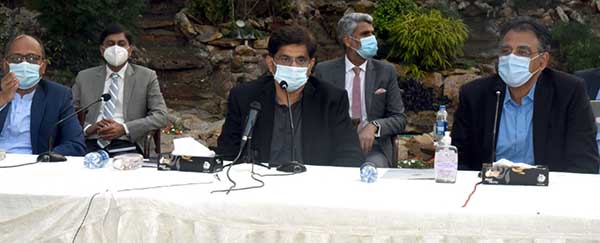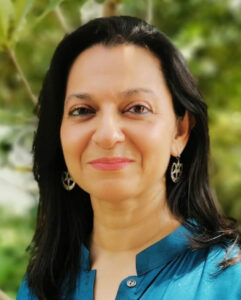
Federal Minister for Planning, Development, Reforms and Special Initiatives & NCOC chief.
Karachi. The city of lights. The city which welcomes migrants from all over the country and which generates a bulk of the national revenue, is also one of the most neglected provincial capitals in the country in terms of development.
The PTI government rode to power in the 2018 general elections with a resounding backing from the people of Karachi and hopes of seeing positive changes in the city were high. But two years on, little seems to have changed.
As the city’s infrastructure crumbled further after heavy rains last year, the federal government announced the Karachi Transformation Package to bring relief to the beleaguered city. Six months on, we caught up with Federal Minister for Planning and Development, Asad Umar, to find out where the Transformation projects stand today and when they will start delivering on the ground.
The ‘historic’ one trillion Karachi Transformation Package was announced in September last year. But we do not see it delivering on the ground as yet. What is the reason for that?
The total package is for 1.1 trillion rupees. Of this, 625 billion rupees will be invested by the federal government and the rest by the provincial government. With the 625 billion, five projects will be implemented by the federal government.
First, there is the Green Line project. The LC for this is open; some contracts have been awarded, bids are open for others and the physical construction of the project is 95 percent complete. We should see the buses running on the roads by August this year and this will be the first modern transport project to be implemented in Karachi.
How many people will this project cater to in a megapolis like Karachi?
This is the first of six such lines. It will carry up to 2.5 lakh commuters a day. The total figure will obviously be much higher when all lines are complete.
Moving on, the second project is the one which started off the whole programme: storm water drainage. The three big nullahs which the federal government is responsible for are the Gujjar nullahs, Korangi and Mehmoodabad. The designs for these have been drawn up by NED and approved by the Apex Committee. On the basis of that, the affected families who were to be displaced have been compensated. Those homes have been moved and construction has begun. The same process is underway on the other drains. By July or August this year, we will have three big storm water drains and sewerage lines. Roads are also being constructed alongside the drains to prevent encroachments from springing up. These are big roads and completion of the roads may take a little longer, but all this will be done within the year.
The third project, Karachi Circular Rail (KCR) and Freight Corridor, are both railway projects. For the KCR, the consultant has been appointed; this is being done as a Public-Private Partnership, and bids should be invited by the middle of the year for private sector investment. The same is true for both the railway projects.

One component of the KCR has to be done by the FWO (Frontier Works Organisation) as per the order of the Supreme Court. They will construct 24 underpasses and overpasses. Things are being processed so that work can start.
Therefore, by September this year, which will mark the first anniversary of the Karachi Package being announced, the storm water drains will be constructed (at least the ones the federal government is responsible for), the BRT [Bus Rapid Transit] will be running on the ground, bids from the private sector for the KCR and Freight Corridor will have been invited and may possibly have been awarded. So you will see these tangible results in the first year. And this includes projects like the KCR which we have been hearing about for the last 30 years.
The fifth and most complicated project, which is also taking the longest, is the K4 water project. This will bring in 260 million gallons of water from Keenjhar. This project was initiated 10 years ago but was halted two years ago because of some serious design flaws. The scheme was re-designed and re-engineered and then approved by the Sindh government. The project was transferred to the federal government at the beginning of this year. WAPDA is now the executing agency for the project and is finalising things before proceeding. The physical work for that will only have just begun by our first anniversary. At best.
One criticism of the Karachi package is that it does not address the structural problems of governance; the fact that power needs to be devolved to the local bodies if any real progress is to be made.
You are only criticising this aspect. Asad Umar and Imran Khan are petitioners in the Supreme Court on this issue. This is essential. What we are doing now is patchwork. The federal government of Pakistan is coming in and doing work which should be done by the local government because the local government has no power or resources.
I’ll give you an example of this lack of resources. During Covid, we increased the capacity for critical care in emergency units of hospitals. Abbasi Shaheed Hospital in Karachi is run by the KMC. We gave them beds, oxygen etc but two months later there was a ruckus that the hospital couldn’t run because people weren’t being paid salaries.
One small thing we have negotiated with the Sindh Government and they agreed to it was that city-based bodies like the Water and Sewerage Board and the Building Control Authority, which were all made provincial subjects, will be moved back to Karachi. At least six months have passed, but it still hasn’t been done.
A mega city like Karachi which generates so much revenue should not really be in need of assistance from the federal coffers. Why do you think this has not been achieved?
Karachi generates more than 90 percent of Sindh’s revenue and about 40 percent of the national revenue but gets very little. That’s what our petition is addressing; the constitution says that there shall be a local government system which is administratively, financially and politically empowered. But the current local bodies system is none of the above. If Karachi and the other cities of Sindh, like other cities of Pakistan, had a local government system consistent with the constitution, we wouldn’t have this problem.
Where does the petition stand now?
PTI and MQM had filed petitions and the case was heard in the Supreme Court. Judgement is reserved.
Prevalence of encroachments is another major issue which is not being addressed, barring minor, half-hearted operations here and there. More than 60 percent of Karachi’s population lives in squatter settlements. Many experts call it ruralisation of the urban centre. Shouldn’t transforming Karachi into an organised, modern city be high on the agenda?
Of course! The matter of encroachments needs to be addressed but that is a provincial subject. The federal government has no mandate in that area. The only encroachment removal included in the scope of the Karachi package was in the construction of the storm drains. And this removal was also done by the Sindh government, based on the NED design. Of course, others should be removed but the federal government has no control over that.
To be fair, the federal government has limited power to improve Karachi. Shouldn’t the issue of the way Karachi is administered be addressed? Should it, perhaps, be divided into administrative units?
In Karachi, all on-ground powers are either with the provincial or local government — and rightly so. We are actually against making more districts upon districts. Karachi already has a fragmented ownership structure. The real issue is that there has to be an elected body which has powers as conceived in the constitution of Pakistan. The structure is there and so is the governing body, but that body is powerless.
You will agree that Karachi wholeheartedly voted for PTI in the last elections, but the party does not seem to have built on that goodwill. Karachiites feel a little let down. What is your opinion on this?
We heard all this before the last elections too, that Karachiites were disgruntled, but we won 14 seats. Let’s wait for the next elections and we will see where PTI stands.
We can all agree that the Karachi Package is historic. And you will see tangible progress within a year of its being announced. Can anyone claim that any federal government in history has done this kind of work for Karachi? With the possible exception of the Musharraf era. So you can say that although we have done more than anyone has ever done before for Karachi, but it deserves even more. Then no argument.
The main issue with Karachi is not just funding, it is governance. Those who have power and control over virtually all organs and institutions which administer the city belong to a party which does not represent the citizens of Karachi.
So what is the way forward?
Inshallah tabdeeli puray Sindh mein ayegi. Next time we will have a PTI government in Sindh and things will change.
Let me tell you, taking on the Karachi Package was a very contentious decision within PTI, given all the mistrust with the Sindh government. But we still did it for this very reason: finding a way forward. As things stand right now, if we want to do anything for the people of Karachi, we have to have a working relationship with the Sindh government. And even risk our political capital, if necessary, because what good is that political capital if it does not deliver any benefit to the people of Karachi.
And what has the experience been like so far?
It’s a mixed bag. We have had periods of working relatively well together, but we are going through a lean patch right now.

The writer is a prominent freelance journalist and runs her own interiors and lifestyle online publication.


Honorable minister has not disclosed figures of 5 individual schemes. Besides The green line was over 65 percent complete when PTI came into power . Now when according to him it is 95 percent physical infrastructure is complete. And at the same time much of it has been rotting and rusting as well. Now it will require another package to put it back into working condition. And what is the rationale of announcing 1100 b rupees package when fed govt contribution announcement is mere 650 b .